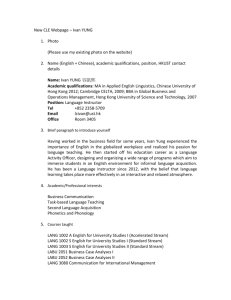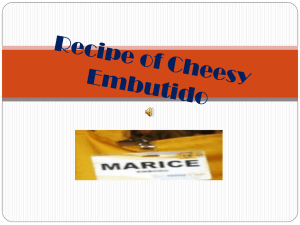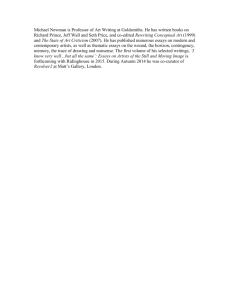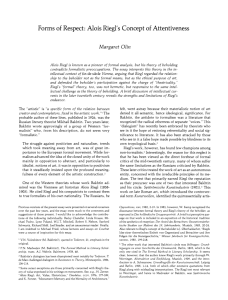Professor Karen Lang - University of Southern California
advertisement
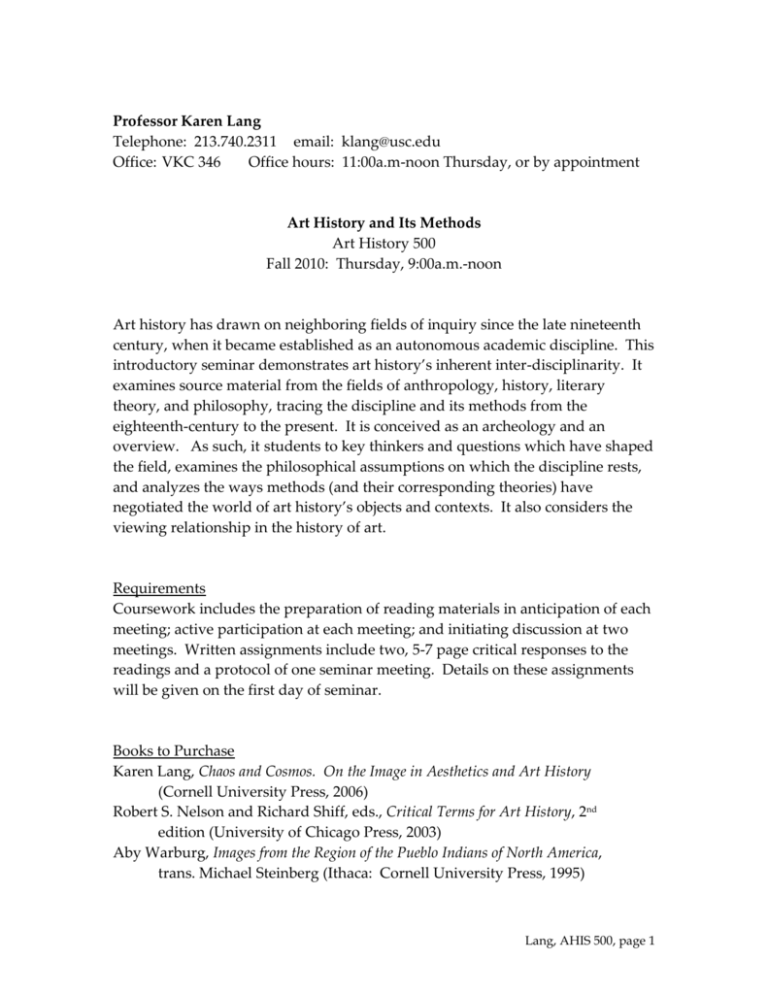
Professor Karen Lang Telephone: 213.740.2311 email: klang@usc.edu Office: VKC 346 Office hours: 11:00a.m-noon Thursday, or by appointment Art History and Its Methods Art History 500 Fall 2010: Thursday, 9:00a.m.-noon Art history has drawn on neighboring fields of inquiry since the late nineteenth century, when it became established as an autonomous academic discipline. This introductory seminar demonstrates art history’s inherent inter-disciplinarity. It examines source material from the fields of anthropology, history, literary theory, and philosophy, tracing the discipline and its methods from the eighteenth-century to the present. It is conceived as an archeology and an overview. As such, it students to key thinkers and questions which have shaped the field, examines the philosophical assumptions on which the discipline rests, and analyzes the ways methods (and their corresponding theories) have negotiated the world of art history’s objects and contexts. It also considers the viewing relationship in the history of art. Requirements Coursework includes the preparation of reading materials in anticipation of each meeting; active participation at each meeting; and initiating discussion at two meetings. Written assignments include two, 5-7 page critical responses to the readings and a protocol of one seminar meeting. Details on these assignments will be given on the first day of seminar. Books to Purchase Karen Lang, Chaos and Cosmos. On the Image in Aesthetics and Art History (Cornell University Press, 2006) Robert S. Nelson and Richard Shiff, eds., Critical Terms for Art History, 2nd edition (University of Chicago Press, 2003) Aby Warburg, Images from the Region of the Pueblo Indians of North America, trans. Michael Steinberg (Ithaca: Cornell University Press, 1995) Lang, AHIS 500, page 1 Schedule of Meetings August 26: Introduction September 2: The “Art” of Art History J. J. Winckelmann, Reflections on the Imitation of Greek Works in Painting and Sculpture [1755] (La Salle, Illinois: Open Court, 1989), 1-7, 33-43, 57-69, 7175. Alex Potts, Flesh and the Ideal: Winckelmann and the Origins of Art History (New Haven and London: Yale University Press, 1994), “Chapter One, Inventing a History of Art,” 11-46, 256-262. Anthony Vidler, “The ‘Art’ of Art History: Monumental Aesthetics from Winckelmann to Quatremère de Quincy,” Oppositions 25 (Fall 1982): 53-66. Aby Warburg, “The Emergence of the Antique as a Stylistic Ideal in Early Renaissance Painting” [1914] in The Renewal of Pagan Antiquity, trans. David Britt (Los Angeles: Getty Research Institute, 1999), 271-273. September 9: Labor Day Holiday?? September 16: History, Objectivity, Fiction Friedrich Nietzsche, “On the Utility and Liability of History for Life,” Thoughts Out of Season, II [1874] in The Nietzsche Reader, ed. Keith Ansell Pearson and Duncan Large (London: Blackwell, 2006), 124-141. Michel Foucault, “Nietzsche, Freud, Marx” [1967] in Essential Works of Michel Foucault, vol. 2, ed. James D. Faubion (New York: The New Press, 1998), 269-278; and “The Subject and Power” [1982] in Essential Works of Michel Foucault, vol. 3, ed. James D. Faubion (New York: The New Press, 2000), 326-348. Hayden White, Tropics of Discourse. Essays in Cultural Criticism (Baltimore: Johns Hopkins University Press, 1985 [1978]), “The Fictions of Factual Representation,” 121-134; and “The Irrational and the Problem of Historical Knowledge in the Enlightenment,” 135-149. Karen Lang, Chaos and Cosmos, “Introduction, Theory Begins with Looking,” 1-11, 215-216; and “Conclusion, Encountering the Image,” 179198, 269-275. Lang, AHIS 500, page 2 September 23: Art History’s Conceptual and Philosophical Underpinnings Immanuel Kant, “An Answer to the Question: What is Enlightenment?” [1784], rpt. in What is Enlightenment? Eighteenth-Century Answers and Twentieth-Century Questions, ed. James Schmidt (Berkeley and Los Angeles: University of California Press, 1966), 58-64. Immanuel Kant, Critique of Judgment [1790], trans. Werner S. Pluhar (Indianapolis, IN: Hackett Publishing Co., 1987), 3-54, 57-65, 68-69, 85-95, 97-126, 209-214, 225-232 (167-212, 214-220, 223, 237-244, 244-266, 337-341, 351-356). Karen Lang, Chaos and Cosmos, “Chapter Two, The Dialectics of Decay: Rereading the Kantian Subject,” 41-87, 227-243; and “Afterword, Toward an Aesthetic Way of Knowing,” 199-214, 275-278. September 30: no seminar meeting October 7: Form Heinrich Wölfflin, Principles of Art History [1915], trans. M. D. Hottinger (New York, 1950), 1-23, 73-75, 124-126, 155-159, 196-197, 226-237. Karen Lang, Chaos and Cosmos, “Chapter One, Points of View in Panofsky’s Early Theoretical Essays,” 12-40, 216-227. Whitney Davis, “Formalism in Art History,” in Encyclopedia of Aesthetics, vol. II, ed. Michael Kelly (New York: Oxford University Press, 1999), 221225. Clement Greenberg, “Towards a Newer Laocoön” [1940], repr. in Pollock and After. The Critical Debate, 2nd ed., ed. Francis Frascina (New York: Harper & Row, 2000 [1985]), 61-70. Clement Greenberg, “Modernist Painting” [1960], repr. in Clement Greenberg: The Collected Essays and Criticism, vol. 4, ed. John O’Brian (Chicago and London, 1993), 85-93. Leo Steinberg, “Other Criteria,” in Other Criteria. Confrontations with Twentieth-Century Art (New York: Oxford University Press, 1972), 55-91, 406-408. Yve-Alain Bois, Painting as Model (Cambridge, Mass.: MIT Press, 1993 [1990]), “Introduction: Resisting Blackmail,” xi-xxx, 259-262 and “Kahnweiler’s Lesson,” 65-97, 280-293. Lang, AHIS 500, page 3 October 14: Style Alois Riegl, Late Roman Art Industry [1901], trans. Rolf Winkes (Rome: G. Bretschneider, 1985), “The Main Characteristics of the Late Roman Kunstwollen,” 223-234. Alois Riegl, Problems of Style. Foundations of a History of Ornament [1893], trans. Evelyn Kain (Princeton, N.J.: Princeton University Press, 1992), “Introduction,” 3-13 and “The Geometric Style,” 14-40. Alois Riegl, “The Place of the Vapheio Cups in the History of Art” [1900] in The Vienna School Reader, ed. Christopher Wood (New York: Zone Books, 2003), 105-127. Willibald Sauerländer, “From Stilus to Style: Reflections on the Fate of a Notion,” Art History 6, no. 3 (September 1983): 253-270. Ernst Gombrich, “Norm and Form. The Stylistic Categories of Art History and their Origins in Renaissance Ideals” [1961] in Norm and Form: Studies in the Art of the Renaissance (London: Phaidon, 1971), 81-98, 149. Meyer Schapiro, “Style” [1953] in Aesthetics Today, rev. ed., ed. Morris Philipson and Paul Gudel (New York: New American Library, 1980 [1961]), 137-171. Kurt W. Forster, “Critical History of Art or Transvaluation of Values?” New Literary History 3, no. 3 (Spring 1972): 459-470. Carlo Ginzburg, “Style as Inclusion, Style as Exclusion,” in Picturing Science, Producing Art, ed. Caroline A. Jones and Peter Galison (New York: Routledge, 1998), 27-54. Recommended: Karen Lang, Chaos and Cosmos, “Chapter One, Points of View in Panofsky’s Early Theoretical Essays,” 12-40, 216-227 (review October 5th); and “Chapter Four, The Experience of Time and the Time of History: Riegl’s Age Value and Benjamin’s Aura,” 136-178, 255-269. October 21: Symbolic Form Ernst Cassirer, An Essay on Man. An Introduction to a Philosophy of Human Culture (New Haven: Yale University Press, 1944), 1-41. Aby Warburg, Images from the Region of the Pueblo Indians of North America, trans. Michael Steinberg (Ithaca: Cornell University Press, 1995). Karen Lang, Chaos and Cosmos, “Chapter 3, Goethe, Warburg, Cassirer: Symbolic Form as Orientation,” 88-135, 244-255. Recommended: Edgar Wind, “Warburg’s Concept of Kulturwissenschaft and its Meaning for Aesthetics” [1931], in The Eloquence of Symbols. Studies in Humanist Art (Oxford University Press, 1983), 21-35. Lang, AHIS 500, page 4 October 28: no seminar meeting November 4: Marxism and the Social History of Art Karl Marx, The Grundrisse [1857-58], ed. and trans. David McLellan (New York: Harper & Row, 1971), “General Introduction,” 16-46. Karl Marx, Capital [1867], abridged ed. (Oxford and New York: Oxford University Press, 1995), “Commodities,” 13-50 and “Exchange,” 51-57. Karl Marx and Frederick Engels, Communist Manifesto [1848], “Bourgeoisie and Proletarians,” 8-26 and “Proletarians and Communists,” 27-39. Timothy J. Clark, “The Conditions of Artistic Creation,” [1974] in Critical Times: The History of the Times Literary Supplement, ed. Derwent May (London: Harper Collins, 2001), 248-253. Timothy J. Clark, The Painting of Modern Life. Paris in the Art of Manet and his Followers, rev. ed. (Princeton, NJ: Princeton University Press, 1999 [1985]), “Introduction,” 3-22, 271-272 and “Olympia’s Choice,” 79-146, 281-297. Griselda Pollock, “Vision, Voice and Power: Feminist Art History and Marxism” [1982], excerpt in Art in Modern Culture: An Anthology of Critical Texts, ed. Francis Frascina and Jonathan Harris (New York: IconEditions, 1992), 28-31. Timothy J. Clark, Farewell to an Idea: Episodes from a History of Modernism (New Haven: Yale University Press, 1999), “Introduction,” 1-13, 409. November 11: Semiotics (Structuralism) Ferdinand de Saussure, “The Linguistic Sign” [1912], in Semiotics: An Introductory Anthology, ed. Robert E. Innis (Bloomington: Indiana University Press, 1985), 24-46. Roland Barthes, “The Structuralist Activity” [1963], in Critical Essays, ed. and trans. Richard Howard (Evanston, IL: Northwestern University Press, 1972), 213-220. Mieke Bal and Norman Bryson, “Semiotics and Art History,” The Art Bulletin 73, no. 2 (June 1991), 174-208. Rosalind Krauss “The Motivation of the Sign,” in Picasso and Braque: A Symposium, ed. Lynn Zelevansky (New York: Museum of Modern Art and Harry N. Abrams, 1992), 261-286. Lang, AHIS 500, page 5 Rosalind Krauss, “Chapter Two, Analytic Space: futurism and constructivism,” in Passages in Modern Sculpture (Cambridge, MA: MIT Press, 1981 [1977]), 39-67, 290-292. Optional: Terry Eagleton, Literary Theory. An Introduction (Minneapolis: University of Minnesota Press, 1983), “Chapter Three, Structuralism and Semiotics,” 91-126, 220-221. November 18: Postmodernism (Poststructuralism) Roland Barthes, “The Death of the Author” [1968] in Image, Music, Text, trans. Stephen Heath (New York: Hill and Wang, 1977), 142-148. Michel Foucault, “What is an Author?” [1969], in Aesthetics, Method, and Epistemology, vol. 2, ed. James D. Faubion (New York: The New Press, 1998), 205-222. Rosalind Krauss, “Sculpture in the Expanded Field” [1979], in The AntiAesthetic. Essays on Postmodern Culture, ed. Hal Foster (New York: The New Press, 1998 [1983]), 31-42. Craig Owens, “The Allegorical Impulse: Toward a Theory of Postmodernism,” Parts I and II [1980] in Beyond Recognition: Representation, Power, and Culture, ed. Scott Bryson, et al, (Berkeley and Los Angeles: University of California Press, 1992), 52-87. Optional: Andreas Huyssen, “Mapping the Postmodern” [1984], in After the Great Divide: Modernism, Mass Culture, Postmodernism (Bloomington and Indianapolis: Indiana University Press, 1986), 178-221, 235-240. Terry Eagleton, Literary Theory. An Introduction (Minneapolis: University of Minnesota Press, 1983), “Chapter Four, Post-Structuralism,” 127-150, 221. November 25: Feminism, Essentialism, and Queering Art History Linda Nochlin, “Why Have There Been No Great Women Artists?” [1971] in Women, Art, Power and Other Essays (New York: Harper & Row, 1988), 93-116. Grisela Pollock, “Modernity and the Spaces of Femininity” [198x] in The Expanding Discourse: Feminism and Art History, ed. Norma Broude and Mary D. Garrard (Boulder, CO: Westview Press, 1992), 245-267. Margaret D. Carroll, “The Erotics of Absolutism: Rubens and the Mystification of Sexual Violence,” Representations, 24 (Winter 1989): 3-30. Available through JStor (http://www.jstor.org/stable/2928464) Lang, AHIS 500, page 6 Judith Butler, Gender Trouble. Feminism and the Subversion of Identity, 2nd ed. (New York: Routledge, 1999 [1990]), “Subjects of Sex/Gender/Desire,” 3-44, 193-202. E.A. (Elizabeth A.) Grosz, Space, Time, and Perversion: Essays on the Politics of Bodies (New York: Routledge, 1995), ”Chapter 3, Sexual Difference and the Problem of Essentialism,” 45-58, 233 and “Chapter 11, Re-figuring Lesbian Desire,” 173-186, 244-245. December 2: Anthropology and Art Clifford Geertz, The Interpretation of Cultures: Selected Essays, (New York: Basic Books Publishers, 1973), “Chapter 1, Thick Description: Toward an Interpretive Theory of Culture,” 3-30. Natalie Zemon Davis, Society and Culture in Early Modern France (Stanford, CA: Stanford University Press, 1975) “Printing and the People,” 189-226, 326-336. Alfred Gell, Art and Agency: An Anthropological Theory (Oxford, UK: Clarendon Press, 1998), “Chapter 1, The Problem Defined,” 1-11, “Chapter 2, The Theory of the Art Nexus,” 12-27 and “Chapter 7, The Distributed Person,” 96-154. Cecily J. Hillsdale, “Constructing a Byzantine Augusta: A Greek Book for a French Bride,” The Art Bulletin, 87, no. 3 (September 2005): 458-483. Lang, AHIS 500, page 7



